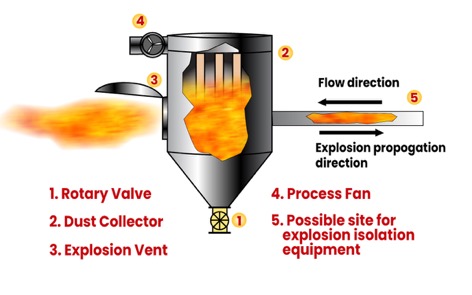
Making pellet operations safer by isolating the problem
November 17, 2021
By Gordon Murray, Executive Director, WPAC
 Wood dust deflagration isolation. Explosions can propagate to other locations in the plant. However, these risks can be mitigated with explosion suppression technologies, which quench the fire and contain the explosion. This explosion isolation prevents it from spreading throughout the entire process plant. Figure courtesy of CV Technology.
Wood dust deflagration isolation. Explosions can propagate to other locations in the plant. However, these risks can be mitigated with explosion suppression technologies, which quench the fire and contain the explosion. This explosion isolation prevents it from spreading throughout the entire process plant. Figure courtesy of CV Technology.
The Wood Pellet Association of Canada (WPAC), BC Forest Safety Council (BCFSC) and Dalhousie University recently partnered on an initiative to improve pellet industry practices regarding equipment isolation with an eye on minimizing the impact of potential combustible dust fires, explosions and deflagrations within wood pellet plants.
Although the industry’s goal is to eliminate such incidents altogether, we also want to ensure that if such an incident should occur, that any damage would be effectively isolated. Process safety and hazard analysis expert Kayleigh Rayner Brown, P.Eng., M.A.Sc., director of Obex Risk Ltd. was commissioned to lead a project on analyzing deflagration isolation for safer operation and is conducting the work alongside BCFSC safety advisor Bill Laturnus. Funding for the project was provided by Dalhousie University, arranged by Dr. Paul Amyotte.
Combustible wood dust presents a significant risk of fires and explosions in all wood products manufacturing facilities – including wood pellet plants – where much of the machinery and equipment used has a propensity for generating ignition sources and the processes can involve suspended dust and dusty conditions. A mere spark can cause a dust explosion or serious fire and result in catastrophic loss of life, injuries, and destruction of buildings. And often these incidents will spread throughout an entire production facility rather than being isolated to an individual process area within the plant.
In a dust explosion, the deflagration processes happen so rapidly that the heated air and gaseous fire products (such as carbon dioxide) produce air pressure so extreme it can blow out walls and destroy structures. Deflagration also has the potential to create secondary explosions. This project is focussed on best practices aimed at isolating the potential for this kind of event.
“Basically deflagration can happen in any piece of equipment and the risk is it can have a domino effect and create a secondary explosion, sometimes worse than the first explosion because in a processing facility everything is connected by things like chutes, conveyors and ducts,” says Rayner Brown. “The key is to isolate or confine the event to the one piece of equipment so it can’t propagate from say the hammermill to the belt dryer.”
Deflagration and isolation
According to the National Fire Protection Association (NFPA):
- A dust deflagration is defined as “propagation of a combustion zone at a velocity that is less than the speed of sound in the unreacted medium” NFPA 652 (2019).
- Deflagration isolation is the technique for the “interruption or mitigation of flame, deflagration pressures, pressure piling and flame-jet ignition between enclosures that are interconnected by pipes or ducts” NFPA 69 (2019).
The project has involved speaking with subject matter experts from wood pellet plants across Canada, engineering consultants with expertise in combustible dust, as well as experts in deflagration isolation equipment supply. Once completed at the end of the year, Rayner Brown will produce an easily digestible resource and reference for wood pellet producers across Canada that provides:
- information on the different types of deflagration isolation systems that are available;
- information on the installation, operation, and maintenance of these systems to improve understanding;
- summaries of the failure modes and degradation factors associated with these systems; and
- considerations for how these failure modes and degradation factors can be managed to make systems more reliable and effective.
Rayner Brown says it’s clear that conducting a dust hazard analysis (DHA) is key – something that is required under U.S. law but not in Canada. According to Timothy Heneks, P.E. at Dustcon Solutions Inc. a Dust Hazard Analysis (DHA) is a systematic approach to identifying and analyzing the fire and explosion hazards posed by combustible dust within a facility, which is more detailed than a typical walkthrough assessment performed by equipment vendors or insurance companies.
As Rayner Brown has discovered in her interviews, a DHA is just the first step. Incorporating deflagration isolation follows a four-step roadmap:
- Conduct Dust Hazard Analysis (DHA)
- Purchase equipment for recommended deflagration isolation points
- Install deflagration isolation equipment
- Maintain deflagration isolation equipment
While safety is clearly the priority of this work, Rayner Brown says she’s finding that her interview subjects see additional benefits to deflagration isolation.
“In one of my interviews with a pellet producer it became clear deflagration isolation also helped productivity,” explains Rayner Brown. “After adopting this approach, they had an event at the plant that in the past would have taken it down for two weeks but in this case the plant was only down for 24 hours and sustained zero damage.”
The research is nearly completed, and Rayner Brown’s findings and producers’ guide will be ready early in the near year. WPAC will also host a free webinar to go over the key findings – stay tuned for announcements about the invite in the coming weeks.
Print this page